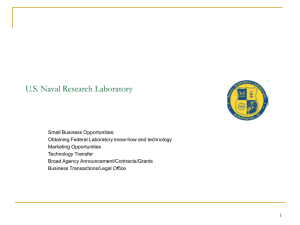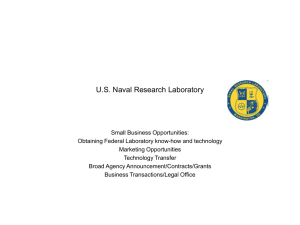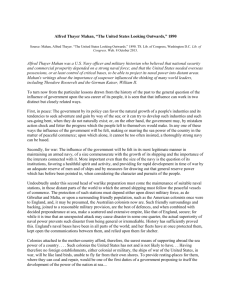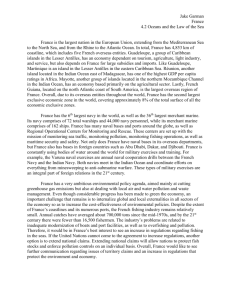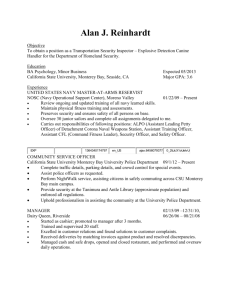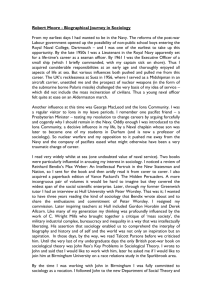Section 101 - Admin Fundamentals
advertisement
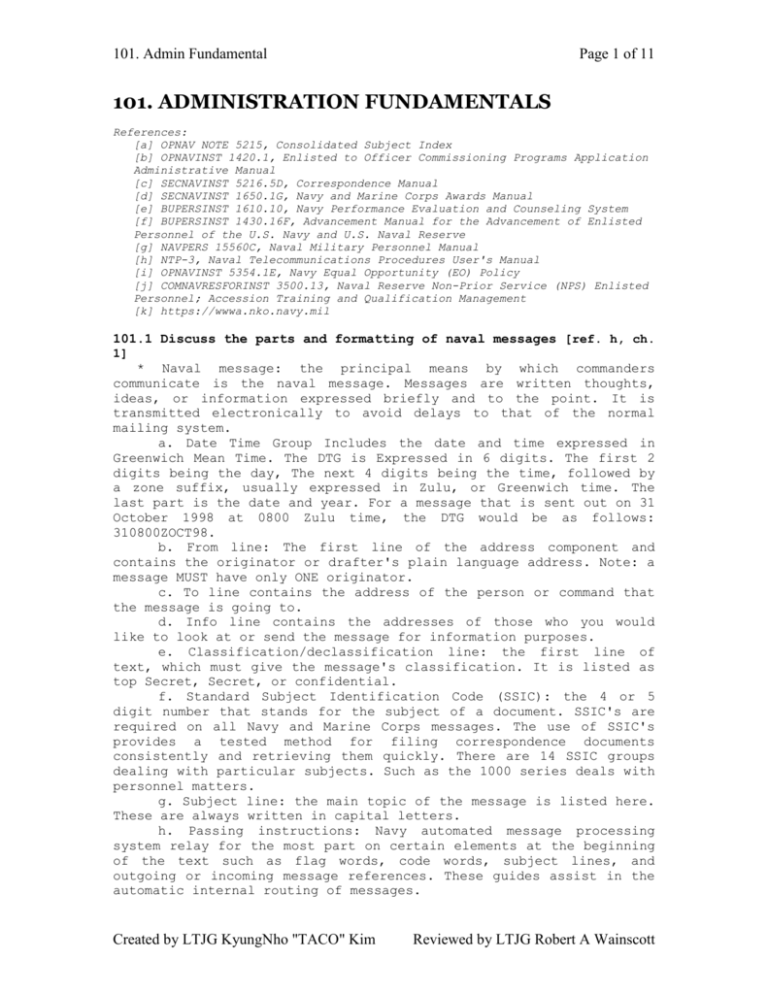
101. Admin Fundamental Page 1 of 11 101. ADMINISTRATION FUNDAMENTALS References: [a] OPNAV NOTE 5215, Consolidated Subject Index [b] OPNAVINST 1420.1, Enlisted to Officer Commissioning Programs Application Administrative Manual [c] SECNAVINST 5216.5D, Correspondence Manual [d] SECNAVINST 1650.1G, Navy and Marine Corps Awards Manual [e] BUPERSINST 1610.10, Navy Performance Evaluation and Counseling System [f] BUPERSINST 1430.16F, Advancement Manual for the Advancement of Enlisted Personnel of the U.S. Navy and U.S. Naval Reserve [g] NAVPERS 15560C, Naval Military Personnel Manual [h] NTP-3, Naval Telecommunications Procedures User's Manual [i] OPNAVINST 5354.1E, Navy Equal Opportunity (EO) Policy [j] COMNAVRESFORINST 3500.13, Naval Reserve Non-Prior Service (NPS) Enlisted Personnel; Accession Training and Qualification Management [k] https://wwwa.nko.navy.mil 101.1 Discuss the parts and formatting of naval messages [ref. h, ch. 1] * Naval message: the principal means by which commanders communicate is the naval message. Messages are written thoughts, ideas, or information expressed briefly and to the point. It is transmitted electronically to avoid delays to that of the normal mailing system. a. Date Time Group Includes the date and time expressed in Greenwich Mean Time. The DTG is Expressed in 6 digits. The first 2 digits being the day, The next 4 digits being the time, followed by a zone suffix, usually expressed in Zulu, or Greenwich time. The last part is the date and year. For a message that is sent out on 31 October 1998 at 0800 Zulu time, the DTG would be as follows: 310800ZOCT98. b. From line: The first line of the address component and contains the originator or drafter's plain language address. Note: a message MUST have only ONE originator. c. To line contains the address of the person or command that the message is going to. d. Info line contains the addresses of those who you would like to look at or send the message for information purposes. e. Classification/declassification line: the first line of text, which must give the message's classification. It is listed as top Secret, Secret, or confidential. f. Standard Subject Identification Code (SSIC): the 4 or 5 digit number that stands for the subject of a document. SSIC's are required on all Navy and Marine Corps messages. The use of SSIC's provides a tested method for filing correspondence documents consistently and retrieving them quickly. There are 14 SSIC groups dealing with particular subjects. Such as the 1000 series deals with personnel matters. g. Subject line: the main topic of the message is listed here. These are always written in capital letters. h. Passing instructions: Navy automated message processing system relay for the most part on certain elements at the beginning of the text such as flag words, code words, subject lines, and outgoing or incoming message references. These guides assist in the automatic internal routing of messages. Created by LTJG KyungNho "TACO" Kim Reviewed by LTJG Robert A Wainscott 101. Admin Fundamental Page 2 of 11 i. Reference lines: an alternative to repeating lengthy reference material within the text of a message. References are always lettered and used in the order that they are referred to. They are written: "As per reference (a) ...” j. Amplifying information line Used to amplify or supplement the data text. k. Narrative information line Used to provide amplifying information which pertains to the data text. l. Text That part of the message known as the "body" or that part which contains the thought or idea the drafter desires to communicate; the reason for the existence of all other parts of the message. .2 Discuss the purpose of the correspondence manual [ref. c, ch. 1] * To prescribe uniform standards for the management and preparation of correspondence. The objective of the DON Correspondence Management Program is to produce effective correspondence efficiently. This manual explains how. .3 Discuss the purpose of 5215 series instruction / notice [ref. a, ch. 1] * THE PURPOSE OF OPNAV 5215.17, NAVY DIRECTIVE ISSUANCE IS FOLLOWING: * establishes uniform standards and practices for management and development of directives within DON. Directives are formal written guidance that informs and instructs DON personnel in the communications of policy and procedures in the performance of their duties. Depending on the purpose and use, a directive may be issued in the form of an instruction, notice, or change transmittal. * Directives may be internal or external. Internal directives are distributed to addressees within the issuing authority’s organization. External directives are distributed to the addressees external to the issuing authority’s organization. *Types of Directives. There are two basic types of directives, permanent and temporary. .4 Discuss the information contained in the enlisted service record [ref. g, art. 1070] a. Page 2 Record of Emergency Data; Used as a reference for beneficiary data should the servicemember die while on active or reserve duty. b. Page 4 Enlisted Qualifications History: for enlisted members. It is a chronological history of occupational and training related qualifications, awards, and commendations. Entries should be made as events occur. c. Page 13 Administrative Remarks: Serves as a chronological record of significant miscellaneous entries which are not provided for elsewhere or where detailed information may be required to clarify entries elsewhere in the service record. Created by LTJG KyungNho "TACO" Kim Reviewed by LTJG Robert A Wainscott 101. Admin Fundamental Page 3 of 11 .5 Discuss types of and requirements for commissioning programs [ref. b] * Each commissioning programs have a different requirements. The most common requirements are: (1) Citizens of the United States. This cannot be waived. (2) Of good moral character and have no record of disciplinary action within 3 years prior to application. (3) Age requirement. For example of Naval Academy: At least 17 years of age and must not have passed their 23rd birthday on Induction Day (the day Midshipman report to the Naval Academy and take their oath of office as Midshipman) of the year entering the Naval Academy. This is a statutory requirement and cannot be waived. (4) Martial status requirement. For example of Naval Academy: Unmarried, not pregnant, and have no incurred obligations of parenthood. (5) Physically qualified. (6) Officially nominated from the Secretary of the Navy or one of the many nomination sources available. (7) Recommended by their commanding officer. * Type of commissioning programs 1. U.S. Naval Academy (USNA) and Naval Academy Preparatory School (NAPS) Programs 2. Naval Reserve Officers Training Corps (NROTC) Program 3. The Broadened Opportunity for Officer Selection and Training Program (BOOST) 4. Officer Candidate School (OCS) Program 5. Seaman to Admiral (STA) Program 6. Enlisted Commissioning Program (ECP) 7. Aviation Enlisted Commissioning Program (AECP) 8. Nuclear Enlisted Commissioning Program (NECP) 9. Enlisted Commissioning Program Civil Engineer Corps Option (ECP-CEC) 10. Medical Enlisted Commissioning Program (MECP) 11. Medical Service Corps In-service Procurement Program (MSC IPP) 12. Limited Duty Officer (LDO) and Chief Warrant Officer (CWO) .6 Discuss enlisted advancement eligibility requirements [ref. f, ch. 3] * Most common advancement eligibilities 1. recommended by CO/OIC 2. in proper path of advancement 3. Meet special requirements (citizenship, security, medical, ASVAB) for certain ratings 4. Successfully complete Service Schools; if required 5. Evaluation completed within computation period for advancement cycle 6. not be a selectee for LDO or CWO 7. Not have pending request for “voluntary” (not high year tenure [HYT]-mandated) transfer to Fleet Reserve (E-7/8/9 candidates) 8. eligibility documented by service record entry 9. performance tests 10. Complete leadership continuum Created by LTJG KyungNho "TACO" Kim Reviewed by LTJG Robert A Wainscott 101. Admin Fundamental Page 4 of 11 11. enlisted Warfare Qualifications 12. pass Navy-wide advancement-in-rate examination 13. Naval Reservists: Satisfactory drill participation in the Naval Reserve 14. Physical Readiness per OPNAVINST 6110.1F 15. Examination Participation for LDO Purposes .7 Discuss the purpose and requirements for accelerated advancement [ref. g, art. 1430] * The accelerated Advancement Program provides an opportunity for graduates of certain Class “A” schools(Other than the Advanced Electronics Field(AEF), Advanced Technical Field (ATF), or Nuclear Field (NF) Programs) to elect accelerated advancement to petty officer third class without competing in a Navy-wide advancement examination. a. Candidates must meet body fat and physical readiness standards and successfully complete the Military Requirements for PO3 correspondence Course and the petty officer Indoctrination course prior to advancement. b. Candidates must be Unites States citizens to be advanced in a rating as requiring access to classified information c. with requirement of additional active duty OBLISERV for AAP of “A” school, National call to Service (NCS) participants are not eligible; however, NCS participants are eligible for AAP of Recruit training. .8 Discuss the Naval Reserve NPS and APG programs [ref. g, art. 1133; ref. j] * National Call to Service: NCS is a short term enlistment program designed to promote and facilitate military enlistment in support of national service. Navy will integrate NCS into current enlisted recruiting program for the purposes of supporting near term active duty manning requirements and future Drilling Reserve manning shortfalls. The NCS program will be funded under Military Personnel, Navy (MPN) * Advanced Pay Grade (APG): individuals enlisting in the Naval Reserve Advanced Pay Grade shall complete the requirements for permanent advancement to applying for recall. .9 State the purpose and layout of a naval letter [ref. c, ch. 2] a. Use the standard letter or one of its variations to correspond officially with addressees in DOD. Also use it when writing to addressees outside DOD if you know they have adopted the format. Outside users include the Coast Guard and some contractors who deal widely with the Navy and Marine Corps. b. The format of the standard letter, with slight variations, sets the pattern for joint letters, multiple address letters, endorsements, directives, memoranda, etc. Important: Before reading further, study the illustration of a two–page standard letter at figure 2-1 and 2-2 below. c. The person whose title appears in the “To:” line is the action addressee. Aside from its one action addressee, the standard letter may have any number of “Via:” addressees, “Copy to:” addressees, or both. Created by LTJG KyungNho "TACO" Kim Reviewed by LTJG Robert A Wainscott 101. Admin Fundamental Created by LTJG KyungNho "TACO" Kim Page 5 of 11 Reviewed by LTJG Robert A Wainscott 101. Admin Fundamental Created by LTJG KyungNho "TACO" Kim Page 6 of 11 Reviewed by LTJG Robert A Wainscott 101. Admin Fundamental Page 7 of 11 d. Margins: Allow 1-inch margins on the top, bottom, and sides of each page. Several exceptions exist. On letterhead paper, typing starts more than 1 inch from the top when the letter head is printed and less than 1 inch if it is typed. Typing may end more than 1 inch from the bottom of the page that has the signature. Don’t justify right margins and don’t use proportional spacing. .10 State the purpose and format of an award submission [ref. d, sec. 2] * Purpose of manual is to provide guidance and regulations concerning awards available to individuals and units in the naval service. * Guidance and regulations concerning Department of Defense (Dodd) awards and those issued by other services are governed by other directives. The manual for Defense and Joint awards is the DoD Manual 1348.33-M of September 1996 (NOTAL) controlled by Office of the Assistant Secretary of Defense, Force Management Policy (ASD FMP). * Commands publishing specific award instructions must comply with the guidance established herein. * PERSONAL AWARD SUBMISSION OF RECOMMENDATIONS 1. At least 3 months should be allowed for the administrative processing of award recommendations. Allow 4 months (120 days) if the recommendation is submitted through a lengthy chain of command or during the summer months. 2. Classified recommendations can be submitted, however, every effort should be made to forward an unclassified recommendation. When not possible, the highest classification which can be routinely handled is SECRET. It is a rare case when an award cannot be administratively processed without classification. If information classified higher than SECRET is essential for proper adjudication, submit the recommendation through the chain of command to: Secretary of the Navy, Special Awards Board, 1000 Navy Pentagon, Room 5E689, Washington, DC 20350-1000. 3. In lifesaving or attempted lifesaving incidents where multiple awards are recommended, all of the recommendations will be forwarded for final action by CNO/CMC even if only one of the recommendations would normally require CNO/CMC approval. In lifesaving or attempted lifesaving incidents involving Naval Reserve (USNR-R) or Marine Corps Reserve (MCR) personnel, the individual must be either serving on "active duty" or otherwise transiting directly to or from his or her drill site to qualify. See Appendix B of this chapter for further information on lifesaving awards. 4. Recommendations may be sent by message or facsimile only in the most unusual circumstances when the importance of a timely presentation justifies special handling. 5. Address recommendations to the awarding authority having jurisdiction over the individual at the time of the act or service. Award recommendations for the Air Medal and above must be submitted via the organizational chain of command, with the first endorsement beginning no lower than Echelon 3 commanders. A list of awarding authorities is provided in appendix B to chapter 1. Provide copies of the recommendation to commanders of intermediate echelons as they Created by LTJG KyungNho "TACO" Kim Reviewed by LTJG Robert A Wainscott 101. Admin Fundamental Page 8 of 11 may make dissenting comments when deemed appropriate to the awarding authority within 2 weeks. In the absence of such comments, concurrence shall be presumed. Do not provide "advance copies" of proposed award recommendations to the chain of command or NDBDM. (Note: An Immediate Superior in Command (ISIC) or a delegated awarding authority may require submission via a lower level chain of command; however, recommendations will not be terminated at any level below the final decision-making authority.) .11 state the purpose and format of a forwarding endorsement [ref. c, ch. 2] a. When a letter is transmitted “Via:” your activity, use an endorsement to forward comments, recommendations, or information. While an endorsement is mostly used for transmitting correspondence through the chain of command, you may also use it to redirect a letter. Don’t use it to reply to a routine letter. b. Many endorsements simply forward letters without substantive comment to the next “Via:” addressee (if any) or action addressee. An endorsement may comment on the basic letter or any preceding endorsements. It may return the basic letter with a final reply or a request for more information. A “Via:” addressee may alter the order of any remaining “Via:” addressees or add other. c. Format: Endorsers may choose to place their signature, authority, and date on the endorser’s “Via:” line. For correspondence that is forwarded with substantive recommendations or comments, excepts as noted below, follow standard letter practice. .12 State the purpose and guidelines for the Enlisted Performance Evaluation and Officer / CPO fitness report [ref. e, encl. 2] * BUPERSINST 1610.10: This enclosure provides an overview of the Navy Performance Evaluation System. While each of the statements in this enclosure constitutes policy, specific actions may require the detailed instructions found in the EVALMAN, enclosure (2). The system utilizes a FITREP for chief petty officers and officers (E7O6) and an EVAL for other enlisted personnel (E1-E6). .13 State the purpose and counseling [ref. e, Annex C] guideline for periodic performance * provides the information needed to conduct performance counseling. It includes counseling schedules, requirements, record keeping, and suggestions for conducting the counseling sessions. The counseling suggestions were developed through research into Navy leadership texts, counseling handbooks of other services, and civilian texts on performance counseling. The suggestions are offered not as a “cookbook” or a replacement for experience, but in the belief that Navy leaders can also profit from the experiences of others. Created by LTJG KyungNho "TACO" Kim Reviewed by LTJG Robert A Wainscott 101. Admin Fundamental Created by LTJG KyungNho "TACO" Kim Page 9 of 11 Reviewed by LTJG Robert A Wainscott 101. Admin Fundamental Page 10 of 11 .14 State the purpose of the reporting senior trait / summary average [ref. e, encl. 1] * First, the reporting senior's summary group and cumulative trait grade averages will be available to detailers and selection boards for comparison purposes. Second, it will be difficult for the reporting senior to allocate promotion recommendations if everyone's trait grades are the same. Definitions are stated relative to both performance in that trait and promotability with respect to that trait. Created by LTJG KyungNho "TACO" Kim Reviewed by LTJG Robert A Wainscott 101. Admin Fundamental Page 11 of 11 .15 Discuss the Navy’s Equal Opportunity policies [ref. i] * no discrimination on the basis of race, color, religion, national origin, sex or age occurs. Personal performance of supervisors and managers in the execution of equal opportunity program responsibilities will be evaluated in their performance appraisals. .16 Discuss the training available via web based resource [ref. k] NKO, self explanatory Created by LTJG KyungNho "TACO" Kim Reviewed by LTJG Robert A Wainscott



